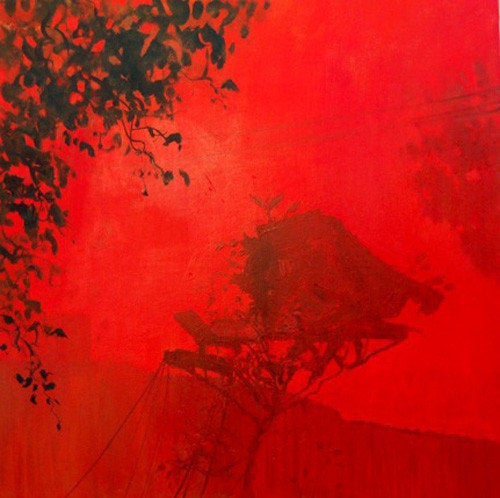

Deborah Brown telling stories about her neighborhood.
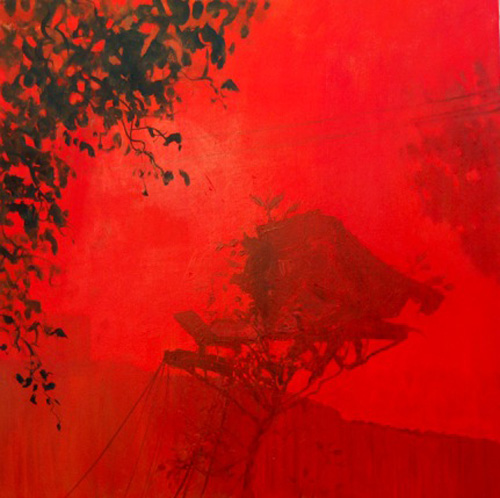
Deborah Brown, "Hybrid #1," 2010, oil on canvas , 36" x 36"
On the occasion of "The Bushwick Paintings," her exhibition at Lesley Heller, I met with Deborah Brown in her studio where we discussed painting and her love of Bushwick, Brooklyn's rising art community.
Sharon Butler: Let's talk about location. You moved to Manhattan in 1982. How has the art world changed since you arrived?
Deborah Brown: Well, now there's Brooklyn. When I moved to NYC there were artist communities in Soho, Tribecca...the East Village was just beginning, but they were all in Manhattan. That's completely changed.
SB: Before you moved to the city, you had a tenure-track position teaching painting at a liberal arts college in Minnesota.
DB: I'd been teaching at Carleton College during the academic year, and in the summer program at Yale. The Yale job in the summer was what got me to New York. I rented a loft in the West 20's near Danceteria. When I got tenure at Carleton, I took a leave of absence for a year to stay here, and I never went back. To support myself, I got a job at the MLA--the Modern Language Association. The MLA represents college English and foreign language professors, much like the College Art Association represents art faculty. I was the Assistant to the Executive Director, which was a secretarial job, but it was a really interesting place because the professors were always in and out-- there was a lot of intellectual activity. I thought it was pretty good for a day job. I did that for quite a while and painted at night.
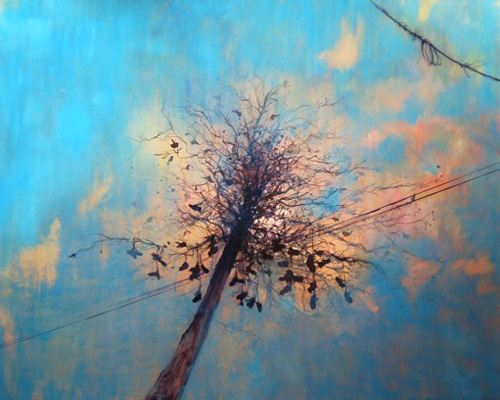
Deborah Brown, "Shoe Tree," 2010, oil on canvas, 48" x 60"
SB: What were your paintings like back then?
DB: I painted expressionistic landscapes and buildings. It was rare to get an exhibition right out of school, but when I moved to NYC, I'd been painting for over five years. I submitted my stuff cold to Tibor de Nagy Gallery. The director, John Post Lee, had seen my work and liked it. The gallery decided to represent me, and I had four shows at there from 1986--1992. I knew fellow Yalies like Peter Halley, who had figured out ways of marketing their work by starting galleries like International with Monument. They showed their own work and produced their own art magazines. People forget that DIY is an old model that has deep roots in New York. Artists wrote about their own work and their friends' work. But it was all in Manhattan and it was a much smaller scene than it is now. At some point, many artists moved to Williamsburg but I completely missed that because I stayed in Manhattan. I came out for Four Walls, but I didn't hang out in Brooklyn until I moved my studio here five years ago.
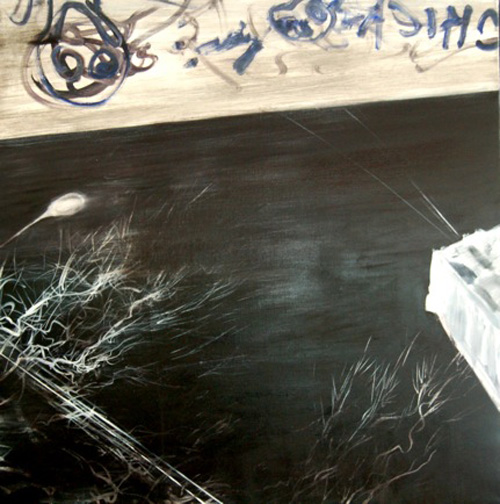
Deborah Brown, "Dick Chicken #3," 2010, oil on canvas, 48" x 48"
SB: What brought you out to Bushwick?
DB: My niece, who was living with us in Manhattan after graduating from college, had decided to sublet a place in Bushwick for three weeks. We moved her to her new place and took her to dinner at the Northeast Kingdom.I'd been to other places in Brooklyn, but I'd never been out to Bushwick...or anywhere near Bushwick(laughs). While we were having dinner at the Northeast Kingdom, artists kept appearing out of the mist to eat there--because there was nowhere else to go. And I had an idea that one of the garages I had seen as we drove around the neighborhood would make a good studio. The neighborhood gripped me immediately and a month later I bought a vacant factory building to use as my studio. I was so sure that this was going to be a fantastic place for artists. I've never felt so strongly about anything in terms of a location. I came to Bushwick with a desire to meet everyone I could. I wanted to know about the community--not just the art community, but my neighbors on the block. I started taking Spanish lessons so I could talk with my neighbors.
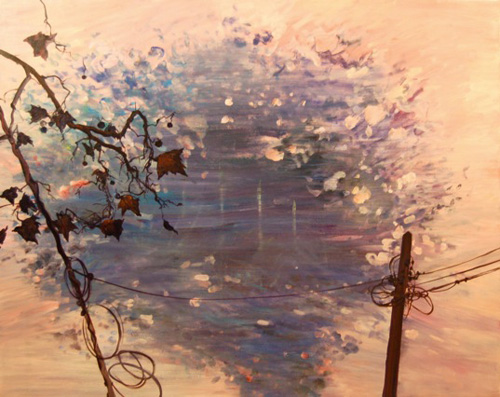
Deborah Brown, "Dream, 2010, oil on canvas, 48" x 60"
SB: What was happening back in your Manhattan art community?
DB: When artists get older, they tend to loose touch with each other. I had been involved with a couple of artist-run discussion groups--a philosophy reading group and a women's artist discussion group--since the early nineties when the commercial art world imploded. Artists banded together and created support groups. I knew a lot of people from those groups, especially women artists, and I loved that, but you become busy with your own lives, and Manhattan is a big place. The scene diversified and moved around--Soho, the East Village, Chelsea, but in Bushwick it is much more concentrated. The small DIY communities in Manhattan had been absorbed into larger commercial communities as the artists gained success. In contrast, almost everyone who was moving to Bushwick was young, which was intriguing, and I felt I could help build a new community. It seemed like a chance to work with others to start something new.
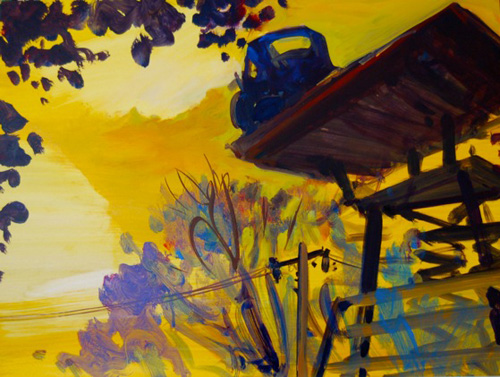
Deborah Brown, "Yard," 2010, oil on masonite, 18" x 24"
SB: Last year you and Jason Andrew (Director of Norte Maar) opened STOREFRONT, a gallery on Wilson Avenue. Has operating the gallery been a good experience?
DB: It's been a fantastic experience and it's led me on a wild goose chase of other things. First of all, being a curator and organizing shows is a fantastic thing for an artist. We all have ideas how we want to show our own work, show our friends' work, and discover new artists.And the artists whom Jason and I have worked with have been wonderful. Many have been helpful getting the shows up and down. Well-known artists have agreed to show their work in small group shows in the project space in the backroom, next to less well-known artists. It's a great spirit, and you don't get that in Manhattan. In Chelsea, everyone is concerned with their reputation, the context of their work. But at STOREFRONT I've never had anyone ask, "Who else is in the show?" Artists trust that we aren't going to embarrass them. Jason Andrew is the best partner in a gallery whom one could hope to have. He is a consummate professional who has wonderful taste and great ideas about everything--programming, installation, presentation. STOREFRONT is a little off the grid, but the gallery has a good reputation among artists, both young and old. And for more established artists, showing at STOREFRONT is a good way to introduce their work to younger artists.
STOREFRONT isn't the only thing going on in the neighborhood. There's Arts in Bushwick. This group really got things going before any of the galleries had opened. They organized events like Bushwick Open Studios in a non-hierarchical way. And now everyone participates in their events, not just the young artists, but the more established artists, too. Chris Harding opened English Kills, Austin Thomas started Pocket Utopia, Kevin Regan and Ellen Letcher opened Famous Accountants, Gwendolyn Skaggs with Sugar, and Factory Fresh--all of these people opened their own galleries. And being involved with STOREFRONT has led to my involvement in non-profit art spaces in Brooklyn. I'm on the board of NURTUREart and Momenta, which involves looking at real estate, raising money, putting on benefits--it's a lot of work, but it's been very satisfying.
SB: Talk about "The Bushwick Paintings" that are on display at Lesley Heller. How has being part of this neighborhood affected your work?
DB: In my earlier work I painted animals in their urban habitats, with the backdrop of the city. I was interested in how those two ecologies interact, not always to the advantage of the animals. I've always painted what's around me. My first response to Bushwick was that this is a visually blighted area, and it IS ugly (laughs). Let's face it, the neighborhood is poor and there's a lot of neglect and trash, and graffiti. But then the way nature is entwined, on the margins, had a resonant chord with me, and related to what I had been painting. I started to see new forms that I really liked--the barbed wire, the satellite dishes, the branches with trash bags stuck on them, the graffiti, dilapidated houses with all kinds of wires coming out of them. It was kind of a crazy area--a little bit like a Tim Burton movie, really wild, and I started painting it. I embraced it quickly and I've been working on this subject matter for the past few years. The new work is completely inspired by my love of this place. I'm very involved with Bushwick--I started STOREFRONT with Jason, I'm on the local community board, my husband and I have a business here. I jog around the neighborhood everyday and see all these things I want to paint.
SB: The interesting thing about your work is how it combines this old-master sense of light and use of materials with these gritty urban scenes, so that there's a sense of the city's resilience, art history, the vitality and creativity in the community, as well as the history of New York. In this new one, you added an image of the Empire State Building.
DB: When you're in Bushwick, you can see the city, it's like Oz but it's surrounded by the architecture of cement factories, water towers, and prosaic urban things that are much more modest. And yet, the two worlds are only twenty minutes away from each other! The two different landscapes are hard to combine, but that's what I'm trying to do in this new painting. I'm trying to paint the space between the two without being too literal or illustrative.
SB: Debbie, you're involved in so many projects. Do you look wistfully back to the days when you simply worked in the studio?
DB: Sometimes, but I think that when artists get older they can become too isolated. It's better to move yourself out of your comfort zone and try new things. Maybe I've gone too far (laughs), but I am having a blast!
----
This post was originally published at Two Coats of Paint.